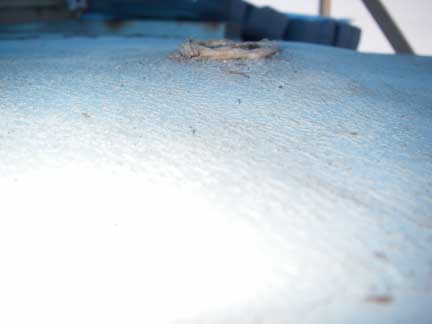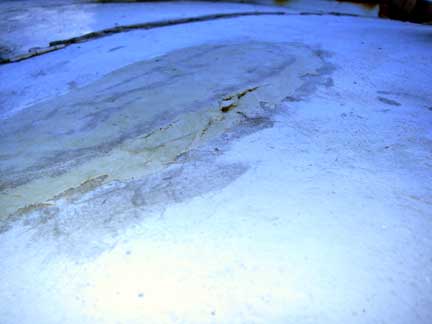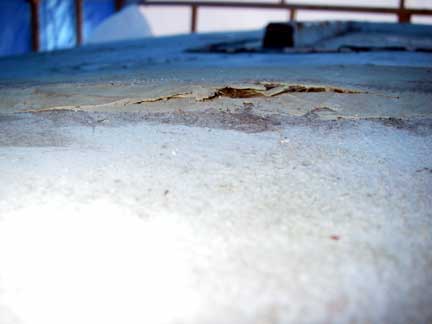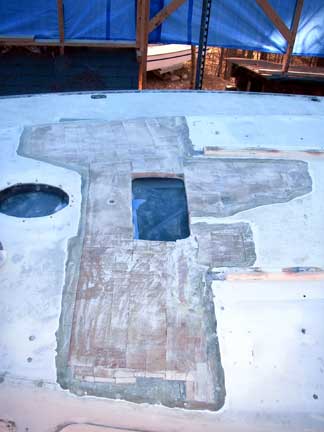Page 1 of 1
Wet Core in a Northern Clime
Posted: Tue Mar 06, 2007 6:51 pm
by catamount
I think last night was one of the coldest we've had all winter, with the temperature this morning about 5 below Zero F. The temperature today never rose above 10 degrees F.
What happens to a balsa-cored fiberglass laminate structure under these conditions, when the balsa wood is fully saturated with water?

This is where the through deck gland for my hydraulic vang was located, in the cabin roof between the mast and the sea-hood over the companionway hatch. Water got in, saturating the core in the area around the gland. Upon freezing, it has formed a significant dome, and cracked the top fiberglass skin. (The extent of the doming is difficult to photograph, but it is really pretty significant!)

In the background you can see an area where a previous patch to the deck has lifted and cracked.

The previous owner of the boat had repaired some areas of damaged core with what appears to be "Great Stuff" foam and then fiberglassed over that. But ultimately that wasn't very effective.

Down below, none of this deformation is noticable; it's mostly the top skin that's a problem.
I'm trying to fit some ventilation hatches in this area between the sea-hood and the mast (working around the hydraulic line, which I suppose could be moved, and the leads for halyards and other lines running from the mast back to winches on the cabin top by the companionway), so all this area will be re-worked one way or another.
Of course, the bigger the holes for the hatches, the less deck that has to be re-cored, right? ;-)
Regards,
Posted: Wed Mar 07, 2007 8:12 am
by Tim
Water: the ultimate solvent. There's nothing on earth that stands up to it over time.
It's rare to see a deck so badly damaged by the freezing cycle of saturated core, but it happens--obviously! Wow.
Posted: Wed Mar 07, 2007 8:53 am
by Tim Mertinooke
At least your "bulges" are above the waterline. I'm heading down today to check on my boat and will look carefully at the few spots I know are saturated on the deck. My hope is that I don't find what you have posted above. Fortunately epoxy and fiberglass in the right hands are wonderful at erasing such evils. We all owe our existence to water's nasty habit of expansion, but boy can it be a pain if you own a boat in New England or some similar climate, especially if a PO didn't understand the value of caulk. Good luck! Tim
Posted: Wed Mar 07, 2007 11:28 am
by Ceasar Choppy
This is interesting. Would be interested to know whether, once it thaws, if there is any delamination that occurs.
Does anyone remember an article in Professional Boatbuilder about a year ago that claimed that frozen water in the core would not lead to delamination? It was a "controversial" study done for SeaRay.
Posted: Wed Mar 07, 2007 11:53 am
by catamount
I suspect that these lifted areas are areas where delamination has already occurred, prior to freezing.
I also suspect that if the deck gland for the hydraulic line was still in place, it would have prevented the frost heaving at that location by acting as a clamp or vice holding the skins and core together.
There is another place on the deck where I know from earlier sounding that there is a void or delamination, but there are no frost heaves there. Maybe the core is all rotted away already...
There are also other areas where I suspect the core is saturated, but there are no frost heaves there either, so I suspect the core and skins may be still well bonded.
But it may be that freezing of wet core does help promote rot of the core and delamination from the skins, but not due to the expansive forces, but rather "frostbite" -- the crystalline structure of the ice breaking the cell membranes of the wood.
Hopefully the weather will warm up enough after the Maine Boatbuilder's Show that I can start tearing into this part of the project again...
Regards,
Tim A.
Posted: Wed Mar 07, 2007 12:03 pm
by catamount
OK, here's another thought about freezing core and delamination, relating to the reported SeaRay study (which I've not seen): if all the core is saturated and it all freezes at once, then all that would happen would be for the whole deck to rise at once -- no cause for breaking bonds between core and skin. In order to do that, you would need some sort of shear couple across those bonds. This you might get if you have patchy areas of core saturation that freeze and expand, so there would be some shear in the core-skin bond right at the edges of these lifted areas. Over the long term I could see this leading to somewhat larger areas of delamination.
Ultimatley, what you need are multiple freeze-thaw cycles -- If it just gets cold and stays cold, you don't get a lot of frost action; you get a lot more frost action when things thaw out during the day and freeze up again at night, repeatedly (that's a little geology for ya).
Regards,
Tim A.
Posted: Wed Mar 07, 2007 7:59 pm
by Rachel
I remember that article; I was thinking of it when I saw the beginning of this thread.
This might be a dangerous paraphrase, but I remember it as basically stating that wet core wasn't necessarily such a big deal. There was data...
The writer did also say that wet core which froze would not cause a delamination problem, I'm pretty sure.
Rachel
Posted: Wed Mar 07, 2007 10:28 pm
by Ceasar Choppy
Found it.
Pro Boat Aug/Sept 2005-- "Wet Balsa Core"
See here:
http://www.proboat-digital.com/proboat/200508/
This is purely academic I guess, but the author suggests that frozen core will not cause delam unless the core is completely saturated... even then, it shouldn't do much because of the flexibility of FG and the natural air voids in the balsa. I've seen a couple marine writers take issue with this article which is why I brought it up. Interesting tho.
Posted: Thu Mar 08, 2007 12:50 am
by catamount
Thanks for that link. Really fascinating.
My one initial comment I have is regarding the author's conclusion that freezing of fully saturated core did not lead to de-lamination --- well, they started the experiment with a (purposely built) delaminated structure to begin with! It's already been split and is free to expand and contract, not constrained like a fully bonded sandwich would be.
(Also, I'm not sure that only 10 or 20 freeze/thaw cycles is really sufficient testing.)
If they had some fully bonded panels where core had become fully saturated (over the years) by cross-grain migration, would repeated freeze/thaw cycling of that specimen have resulted in delamination?
I also think that some of the conclusions about water and fungal spore migration through cores, and the requirement for voids remnant from manufacture for significant water accumulation, may well be applicable to relatively new boats still under warranty (the ones that SeaRay would be worried about), but are too limited in scope for the 20 to 40 year old classic plastics that we deal with here in this forum. In our boats, we've had the years for slow cross-grain migration of water and spores to have taken place in otherwise void-free construction.
Anyway, my final take home message from the article is that with moist cores not yet showing signs of decay, in still fully bonded sandwiches, take a stab at trying to dry it out if you want, and then just seal it up good and leave it alone. Remove all traces of rotten core.
Regards,
Tim A.
Posted: Thu Mar 08, 2007 7:53 am
by Tim
During a quick review of the article just now, specifically the section on frozen cores (I didn't reread the entire thing), the thing that stood out to me, and which calls the results into question, is the manner in which the test panels are constructed, and the fact that they simply don't accurately replicate a cored boat structure in the way they can expand or contract during the test, nor do they properly account (in my opinion) for so many other factors that might have a cumulative effect on our boats.
A boat is much more like the author's example of a glass bottle containing water. If completely filled, there's nowhere for the expansion to go but outwards, breaking, in that example, the bottle. Despite the interconnected nature of a boat's core, I believe it's very possible for a heavily saturated area (akin to the full bottle of water) might not have anywhere to expand other than in a direction which causes skin damage. Water, and ice, take the path of least resistance, and while perhaps such an expansion requires specific conditions, to hypothesize that such damage cannot happen based on the testing performed for the article just seems wrong.
However, I also tend to agree with his conclusion that if the core (or the inside of the bottle) is not fully saturated, there may generally enough room for the ice's expansion. Until there's not. That's when something has to give. Again, just because a lab test didn't show something doesn't mean that there aren't instances, under the right combination of circumstances, where the opposite can't occur. Clearly, the testing doesn't account for many of the factors that can affect a real-world boat.
I think it's wrong for the author to surmise, based on this testing, that freeze/thaw cycles will not create collateral damage to the surrounding areas, possibly in the form of delamination or similar damage. The author seems to completely dismiss the reports from experienced people in the field who say they have seen examples of damage that must be caused by freezing. There's no way to prove that either, but logic dictates those findings, and they are not isolated. I've seen them, and so has any other professional who works in the field in colder climates. It's disingenuous for the author to ignore these actual examples from the field.
That said, I think it's fair to say that certain specific conditions must be met in order to see this sort of damage, including the level of core saturation, the extent of the high saturation, the overall condition of the laminate, the length of time the situation has been allowed to exist, and whether there's room for the ice to expand in non-damaging directions.
20 or 40 years (or even 5 or 10) of annual freeze-thaw cycles, plus the cyclic loads that any boat undergoes as part of normal use, are of course worlds away from 20 freeze-thaw cycles performed in a lab under controlled and limited conditions. I think it's unreasonable to expect any testing to be able to appropriately account for all the factors that might come into play, such as environment, build quality, specific construction issues, weather, cyclic loads, and so forth, and it's therefore unreasonable to propose that the test results can truly tell the full tale.
I guess what I'm saying is that I don't dispute the results of the author's tests, but, as with so many studies, these specific tests simply leave too many variables unaddressed. His testing may have satisfied Sea Ray and its warranty lawyers, which, frankly, is really what this was all about, but that doesn't mean it's the last word, nor the most accurate. Results from the field often fly in the face of canned testing.
Posted: Thu Mar 08, 2007 6:27 pm
by Scout
I totally agree with you about the test Tim.
One thing I found out, being in the middle of a project very similar to this post, is that there was no delamination of the core and skin, only that the rotted core had deteriorated so badly, it came apart. The core never came apart from the skins, just from itself. In fact, we will have to grind the still bonded balsa core from the skins, except for were the core actually tore the first layer of fiberglass from the skin.
Whether to fix the problem or not is a hard one. On Scout, we properly could have put off repairing the damage for a few years without any major loss of structural integrity. Of course, most likely, the area to repair would be larger.
Posted: Thu Mar 08, 2007 10:31 pm
by catamount
SCOUT wrote:...there was no delamination of the core and skin, only that the rotted core had deteriorated so badly, it came apart. The core never came apart from the skins, just from itself. In fact, we will have to grind the still bonded balsa core from the skins, except for were the core actually tore the first layer of fiberglass from the skin.
Yep, I've seen that. I've also seen where the core has de-bonded from
both skins, as well as just one or the other.
SCOUT wrote:Whether to fix the problem or not is a hard one. On Scout, we properly could have put off repairing the damage for a few years without any major loss of structural integrity. Of course, most likely, the area to repair would be larger.
Same with GREYHAWK. Heck, we sailed the boat on a 500+ mile offshore adventure last year with parts of the deck and house in
this condition. But the work's gotta be done sometime, and there are enough leaks through the deck that one of my crew described his off-watches as "like trying to sleep under a lawn sprinkler."
First priority, make the boat doesn't sink. Second priority, make sure the mast stays up. Third priority, keep the water out.
Regards,
Tim A.
Autopsy Report
Posted: Sun Apr 22, 2007 9:34 pm
by catamount
Autopsy Report

This is a view of the current condition of the area shown above where the deck had domed. I cut out for a new ventilation hatch, and cut away the top skin and removed rotten and/or delaminated core from the surrounding area, prepared the area, and glued in new balsa core. I've started grinding out bevels on the adjacent top skin for laying up a new skin.
To orient yourself, you can see the oval hole in the deck for the mast collar to the left, a rectangular hole for the new ventilation hatch (center), and the rails for the companionway sliding hatch (right).
The deck gland for the hydraulic line (as pictured earlier in this thread) was located right at the forward edge of where the ventilation hatch would end up, so I moved it forward 2 inches (you can see the small hole between the mast hole and the vent hatch hole).
The areas outboard of of the companionway hatch (both sides) are cored with plywood for supporting lots of winches and other hardware for halyards and control lines, etc..). The area between the companionway rails and forward was cored with end-grain balsa. At the transition between the two types of coring, the top and bottom skins come together, so the plywood and balsa are isolated from each other.
OK, the area forward of the companionway hatch is the area where the frost-heaving occurred. In this area, and off to both sides, the balsa had delaminated from the bottom skin but was still very well adhered to the top skin. The balsa was very wet but not totally black with rot (although it was just starting to decay from the bottom up).
Clearly, this area had been re-cored once before (consistent with the previous owner's report that he had the deck "professionally" recored once already), but they had not done an adequate job of adhereing the new balsa core to the bottom skin... Interestingly, the "scrim" from the balsa was adhered to the bottom skin. Other evidence that this area had been re-cored once before is that the top skin was made of chopped strand mat instead of woven roving as elsewhere, and that there was no molded in non-skid pattern as elsewhere.
In the area between the companionway hatch rails, the balsa wood
was totally black with rot -- this area obviously had
not been re-cored, as the previous "professional" effort had stopped short of actually unbolting the sea hood over the companionway slider and chasing the rot to its end.
SO, back to the frost-heaves. My hypothesis now is that the wet balsa wood expands horizontally (across grain) when frozen, more so than vertically (along the grain). If the balsa is adhered to both skins, it is constrained and can't go anwhere. If it is delaminated from both skins, then it just crushes itself. It is delaminated from one skin, but still attached to the other, then the attached skin will experience a buckling deformation when the saturated wood freezes.
That's it for tonight (I'll have more project updates soon...)
Regards,
Re: Wet Core in a Northern Clime
Posted: Mon Apr 23, 2007 7:47 am
by catamount
catamount wrote:The previous owner of the boat had repaired some areas of damaged core with what appears to be "Great Stuff" foam and then fiberglassed over that. But ultimately that wasn't very effective.
Forgot to mention in the autopsy report that I think this area cracked because the new top skin the DPO created over this area just wasn't very thick, nor well adhered (insufficient overlap) with the adjacent existing skin. The green nature of the filler he used suggests polyester Bondo, so he may have used polyester resins instead of epoxy to make the repair, too.
Posted: Mon Apr 23, 2007 9:23 am
by DELETED
DELETED
Re: Autopsy Report
Posted: Sat May 05, 2007 8:26 am
by catamount
catamount wrote:
The areas outboard of of the companionway hatch (both sides) are cored with plywood for supporting lots of winches and other hardware for halyards and control lines, etc..). The area between the companionway rails and forward was cored with end-grain balsa. At the transition between the two types of coring, the top and bottom skins come together, so the plywood and balsa are isolated from each other.
Here's a picture from last fall looking at the underside of the deck in this area:










